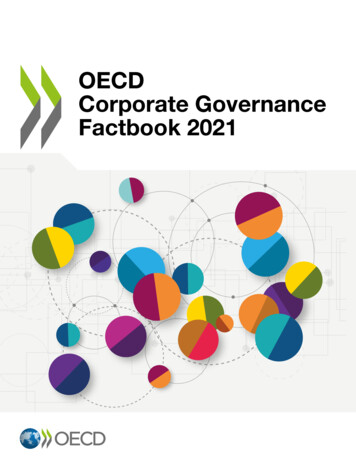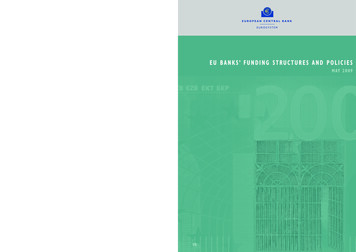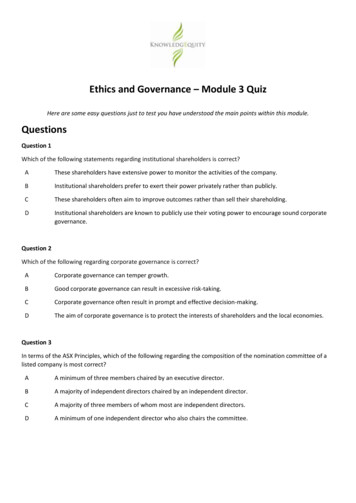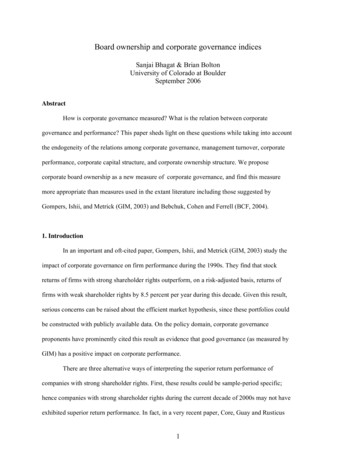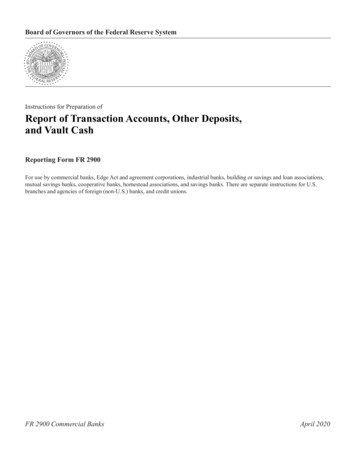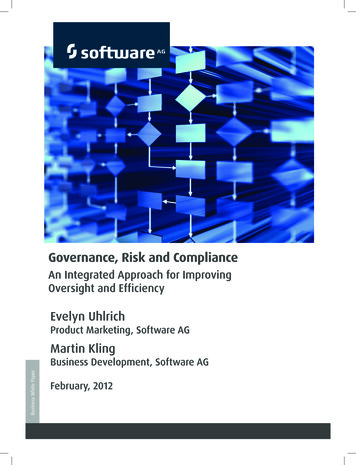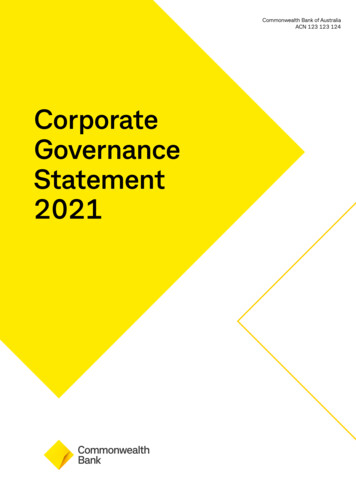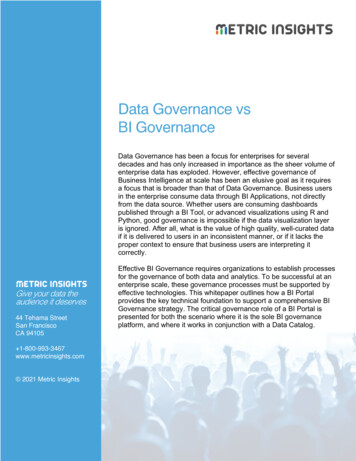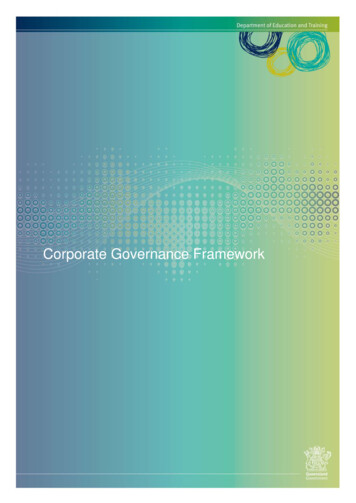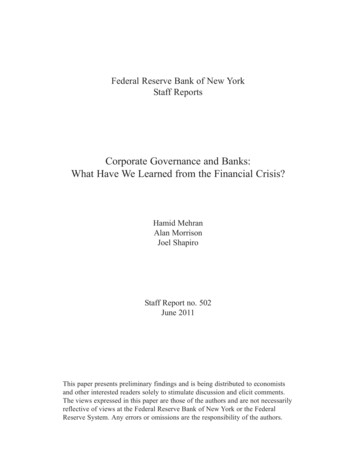
Transcription
Federal Reserve Bank of New YorkStaff ReportsCorporate Governance and Banks:What Have We Learned from the Financial Crisis?Hamid MehranAlan MorrisonJoel ShapiroStaff Report no. 502June 2011This paper presents preliminary findings and is being distributed to economistsand other interested readers solely to stimulate discussion and elicit comments.The views expressed in this paper are those of the authors and are not necessarilyreflective of views at the Federal Reserve Bank of New York or the FederalReserve System. Any errors or omissions are the responsibility of the authors.
Corporate Governance and Banks: What Have We Learned from the FinancialCrisis?Hamid Mehran, Alan Morrison, and Joel ShapiroFederal Reserve Bank of New York Staff Reports, no. 502June 2011JEL classification: G01, G21, G32, G39AbstractRecent academic work and policy analysis give insight into the governance problemsexposed by the financial crisis and suggest possible solutions. We begin this paper byexplaining why governance of banks differs from governance of nonfinancial firms. Wethen look at four areas of governance: executive compensation, boards, risk management,and market discipline. We discuss promising solutions and areas where further researchis needed.Keywords: governance, banksMehran: Federal Reserve Bank of New York (e-mail: hamid.mehran@ny.frb.org). Morrison: SaïdBusiness School, University of Oxford (e-mail: alan.morrison@sbs.ox.ac.uk). Shapiro: SaïdBusiness School, University of Oxford and CEPR (e-mail: joel.shapiro@sbs.ox.ac.uk). We thankparticipants at the conference on The Crisis Aftermath: New Regulatory Paradigms, Xavier Freixas,and Luis Garicano for helpful comments, and Renee Adams, Bernadette Minton, Jérôme Taillard,and Rohan Williamson for sharing their data on board structures. The views expressed in this paperare those of the authors and do not necessarily reflect the position of the Federal Reserve Bank ofNew York or the Federal Reserve System.
11. IntroductionThe financial crisis exposed flaws throughout financial markets and promptedmuch investigation into the way banks work. This paper focuses on one line ofinvestigation—the corporate governance of banks. It examines why governance ofbanks differs from governance of nonfinancial firms and where the governance of banksfailed during the crisis; it also offers recommendations for improving the governancesystem. Bank governance has been the topic of much recent academic work (see table 1)and policy discussion (Senior Supervisors Group 2008, 2009; Walker Report 2009;Committee of European Banking Supervisors 2010). Because of their contemporaneousnature, there has been little connection between the academic approach and policyanalysis. The purpose of this paper is to make such connections and ground the policydebate on scientific evidence.The paper begins by providing a twist on the usual question of what is differentabout banks by asking what differences are important to governance. Two themes—themultitude of stakeholders in banks and the complexity of the business—run throughoutthe paper. Besides shareholders, the stakeholders in banks are both numerous(depositors, debtholders, and the government as both insurer of deposits and residualclaimant on systemic externalities) and large (over 90 percent of the balance sheet ofbanks is debt).Yet shareholders control the firm, and evidence shows that both theboards and the compensation package for CEOs represent the shareholders’ preferencefor increasing risks. That preference, however, is in conflict with the preference of otherstakeholders. Shareholders respond to their incentives; Laeven and Levine (2009) andEllul and Yerramilli (2010) show that the presence of institutional investors increasesthe riskiness of the bank. The goal of increasing risk was largely successful, eventhough the outcome of that increased risk during the crisis was not. 1The natural next question is, What was different about banking in the crisisperiod versus the period before? Here is where the issue of complexity becomesimportant. The business of banks has become more complex and more opaque.Moreover, banks have become much larger and expanded dramatically into otherbusinesses since the passage of the Gramm-Leach-Bliley Act in 1999. The business ofbanks has also been taken up by nonbanks in the “shadow-banking” sector, creatingunregulated and uninsured exposures. This added complexity has made the job of1Cheng, Hong, and Scheinkman (2010) describe how the realization of this risk was successful in the late1990s.
2boards and managers difficult for many reasons. First, the simple number of activities tomanage has multiplied. Second, the knowledge needed to understand these activities hasalso increased substantially. Third, techniques used to manage these activities (such asvalue at risk in the case of risk management and credit ratings for capital requirements)have not performed well under the greater degree of complexity and duress.The paper examines in depth four topics in the corporate governance of banks:executive compensation, boards, risk management, and market discipline. Policyrecommendations are provided where possible, although several issues have no clearanswers. Throughout the paper are references to table 1, which surveys the very recentliterature tying measures of governance to measures of risk and performance in theyears just before and during the crisis. Ideally, the goal would be to gain a robust senseof the role governance plays in risk taking in order to suggest best practices orregulatory guidance. However, the notion of causation is a tricky one: does a givencharacteristic lead a bank to make risky choices, or does a culture of risk taking lead abank to have certain characteristics? Due to this endogeneity problem, most of theserelationships are interpreted here as correlations. Several papers cited in this paper uselags to improve this interpretation. A few papers, denoted with **, use furthereconometric techniques to push this interpretation further. Also, most of these papersfocus on large financial institutions, not just banks. With that caveat, this analysisdiscusses the results as they apply to banks. Last, almost all the correlations display theexpected sign (or at least the sign consistent across datasets). 2The discussion of governance failures begins with a look at executivecompensation, including trends in compensation packages and recent evidencedemonstrating how equity compensation promoted risk taking. The paper then citesrecent research suggesting that linking executive pay to the price of debt can reduceexcess risk. The next topic—board characteristics—includes the size of the board, thenumber of outside directors, the experience of the directors, and their other activities.Although most of the evidence does not point strongly toward immediate reforms,2The main exceptions are when the measures of risk are (1) write-downs and (2) receiving TARP funds.Neither of these is surprising. The meaning of write-downs is debatable. While they signify the realizationof losses, a bank has a certain degree of discretion is taking write-downs, implying they could be a sign ofex ante risk taking (realized in losses) or ex post prudent behavior (managing expectations of how a shockhas affected the firm). Regarding TARP funds, it is not obvious that the worst-off banks were the onesreceiving funds, as there is a survivorship bias and some recent evidence suggests initial mispricing ofrecipients (Ng, Vasvari, and Moerman 2010). Therefore, because of their ambiguity, we will not discussthese two measures.
3reforms do imply trade-offs. The paper then addresses risk taking at the firm and therisk management function. Here, unambiguous evidence shows the need for reform andfor strengthening the risk management roles within the firm. Last, the paper explores therole of market discipline, looking at two specific inputs that permit market discipline tofunction well (or not function well): capital requirements and the size and scope ofbanks. In recent years, banks have found ways to get around capital requirements,diminishing the effect of market discipline. At the same time, banks have increased theirsize, scope, and complexity, making both regulation and market discipline lesseffective. At the same time, not much evidence indicates that structurally changing thebusiness of banks will improve matters because reduced banking also has its problemsand current banks may innovate around regulation. The paper ends with a briefconclusion.2. Why Is the Governance of Banks Different from That of Nonfinancial Firms?Two key differences distinguish the governance of banks from that ofnonfinancial firms. The first is that banks have many more stakeholders thannonfinancial firms. The second is that the business of banks is opaque and complex andcan shift rather quickly. Thus, while this paper will obviously discuss the roles of theboard and of executive compensation, it will also discuss the roles of risk, incentives,and regulation, which may not be critical for nonfinancial firms. 3Banks, which consist of more than 90 percent debt (as opposed to an average of40 percent for nonfinancial firms), have more stakeholders than nonfinancial firms.Beyond the shareholders, the stakeholders in a bank include debtholders, the majority ofwhich are the depositors and the holders of subordinated debt. The deposit insuranceauthority also has an interest in the bank’s health, as its insurance will be called upon inthe case of insolvency. Inasmuch as a bank’s insolvency has negative consequences forthe financial system as a whole (certainly more relevant for larger institutions) and theseexternalities need to be regulated, bailed out, or both at a sizable cost to taxpayers, thegovernment is also a stakeholder in the bank. Furthermore, as depositors are generallysmall and subject to free-rider issues in monitoring, the importance of other nonequitystakeholders increases.3See Adams and Mehran (2003) and Adams (2010) for a discussion of differences between governanceof bank holding companies in the United States and nonfinancial firms.
4Despite the multitude of stakeholders, the board represents solely the views ofshareholders, subject to regulatory constraints. Shareholders’ interests may divergesubstantially from those of other stakeholders, especially on risk, where shareholdersprefer volatility and may have short-term perspectives. Clearly, debtholders andregulators prefer low volatility and take longer-term views. In their model, Bolton,Mehran, and Shapiro (2011) demonstrate that shareholders may not have the incentiveto reduce risk taking at a firm, even if it is in their own interest due to commitmentproblems.The role of leverage differs across industries: in a nonfinancial firm, leverage isa source of financing, while in the banking sector it is a factor of production. Banks willdeploy the cheapest factor in their production function. While debt and equity would beequally expensive in a Modigliani-Miller world, in banking firms that would not be thecase for a number of reasons. In particular, because depositors have access to a statefunded safety net, they are less sensitive to bank risk than other investors and hence donot demand adequate compensation for risk taking when they invest. Ceteris paribus,this tendency renders debt a cheap source of funds and biases banks toward it. Onecould attempt to correct for this bias by charging banks an economic price for theirdeposit insurance protection. However, although a risk-based deposit insurance systemwas adopted in the United States in the mid-1990s, firms still pay a fixed protection rateon their deposits. The structural opacity of banking assets, moreover, makes it very hardto determine a fair price for deposit insurance. 4 As a result, for both practical andtechnological reasons deposit insurance seems to be underpriced, and banks areexcessively willing to lever themselves. And, as a consequence of underpriced debt,many investment opportunities appear unrealistically attractive to bankers. Hence, onecan argue that deposit insurance protection was an important force behind the recentrapid expansion in bank lending and in the size of deposit-taking institutions.At the same time, banks are both opaque and complex. As Levine (2004) notes,“Banks can alter the risk composition of their assets more quickly than most nonfinancial industries, and banks can readily hide problems by extending loans to clientsthat cannot service previous debt obligations.” Moreover, the business of securitizationhas in essence (1) speeded up the process of lending at the origination stage and in4See also Freixas and Rochet (1995).
5interbank markets (for example, repo) and (2) increased opacity by merging largeamounts of information and relying on credit ratings.Academics debate how opaque banks truly are. Morgan (2002) shows that ratingagencies disagree substantially more over ratings on bonds issued by banks than overthose issued by nonfinancial firms. Flannery, Kwan, and Nimalendran (2004) show thatthe trading properties of banks and the accuracy of analysts’ earnings forecasts forbanks are similar to those of nonfinancial firms. Nevertheless, Flannery, Kwan, andNimalendran (2010) show that this similarity broke down right at the beginning of thefinancial crisis in mid-2007. While not a bank, Lehman Brothers and the case of Repo105certainly highlighted the possibility that balance sheets might be manipulated.Opacity and complexity play a role in governance in both the interactionbetween the board and management and the relationship between the bank and itsregulators. The question of how well boards represent shareholders depends on whetherboards understand the inner workings of the bank. While obvious, the notion thatindependent board members should have more financial market experience has becomean important issue (this is discussed in the section on boards).3. Corporate Governance Failures in the CrisisA. Executive CompensationMany view compensation practices as a contributing factor to the currentfinancial crisis. Conventional wisdom holds that the executive pay structure wasdesigned to enhance risk taking and create value for shareholders but not to protectdebtholders. This dynamic was particularly strong in the banking industry becausebanks are highly levered and their leverage is subsidized. What has not been as widelydiscussed is the fact that government subsidies directly affect compensation.The level of executive pay in a nonfinancial firm is generally related to the sizeof the firm’s assets (market value of equity or book value), 5 its asset complexity, andthe industry structure and competition. Leverage has an insignificant effect on pay, and,on average, firms judiciously choose their leverage for its effects on their credit ratingsand potential costs of distress. An industrial firm on average has about 40 percent debtin its capital structure.5For example, see Gabaix and Landier (2008). For more on the relation between the governance ofnonfinancial and financial firms, see Adams (2010).
6A bank’s size and its level of executive pay are highly correlated. Since the depositinsurance system contributes to the size and growth of the firm, it thus contributes to therate of executive pay in the banking industry. For this reason, bank regulators have aneconomic argument for controlling executive pay. In addition, bank boards should takeinto account the effect of compensation on solvency and capital adequacy, and banksshould internalize the costs associated with risk taking.Capital structure can exert a direct influence on the structure of executivecompensation of the bank holding company (BHC). According to agency theory,stockholders want the board to compensate a CEO with stock options since theyincrease the CEO’s pay-performance sensitivity. A higher level of stock options, intheory, motivates the CEO to pursue riskier investment strategies. If the firm has debt inits capital structure, riskier strategies benefit stockholders at the expense of debtholders(see, for example, Jensen and Meckling 1976). In efficient capital markets, however, theincentive for risk taking is anticipated by debtholders, and thus increased reliance onstock options gives rise to a debt premium or cost of raising debt (John and John 1993).The size of the premium is related to the leverage ratio. To reduce the cost of debt,leveraged firms may choose to scale back on their use of stock options. As BHCs arehighly levered institutions, they may therefore want to limit their use of stock optionssince, for example, those options could affect the cost of issuing subordinated debt.John and Qian (2003) and John, Mehran, and Qian (forthcoming) provide support forthis argument and document that the pay-performance sensitivity for CEOs of BHCs islower the higher the ratio of the BHCs’ debt to total assets.1. Compensation TrendsFigure 1 presents mean and median salaries for top executives of banking firms inStandard & Poors’ ExecuComp for the period 1992–2007. The figure shows an upwardtrend in nominal terms in the 1990s and relatively stable pay in 2000s. Figure 2 presentsmean and median bonuses for the same period. While the median bonus is relativelyunchanged, the mean bonus for the industry has generally increased since 1992.However, the sharp drop in bonuses in 2006–07 suggests that pay is related toperformance or that market forces were at work. Figure 3 presents the dollar (BlackScholes) value of stock option grants. The trend follows that of nonfinancials,
7increasing rapidly through 2000, with a sharp drop thereafter. The cause of the drop isnot fully clear. The increased scrutiny of pay following the dot-com bubble, particularlyrelated to stock options, in the era of Sarbanes-Oxley beginning in 2002 is likely to be acontributing factor.Figure 4 presents the vesting schedule of options granted in the period 1996–2007.Twenty percent of options granted to the five top executives at each bank hadimmediate vesting, and nearly 29 percent had vesting of one year. The short-optionvesting may have provided incentives to focus on short-term return. Figure 5 documents7,254 exercises for the top five executives and documents how soon the options wereexercised following vesting. About 34 percent of options were exercised immediatelywhen they were vested. Another 15.5 percent of options were exercised within one yearafter vesting. The evidence in the two charts together suggests that stock options werenot designed to promote decisions compatible with safety and soundness and theprotection of creditors and taxpayers.2. The Link between Compensation, Performance, and Risk Taking during theFinancial CrisisOne might ask why the trends in compensation have changed. In fact, the wave ofderegulation occurring at the end of the 1990s created unprecedented opportunities forrisk taking in the banking industry. Top executives wanted to exploit these riskyopportunities, of course, but did not want to risk their own compensation. Consequently,the landscape of compensation changed, with further reliance on cash compensation andbonuses. Moreover, since 2006 CEOs in the banking sector have had the highest pay ofall executives in the economy.Fahlenbrach and Stulz (2010) find that banks with CEOs whose incentives weremore closely aligned with the interests of shareholders performed worse and find noevidence that they performed better. Banks with higher-option compensation and alarger fraction of compensation in bonuses for their CEOs did not perform worse duringthe crisis. Suntheim (2010) shows that institutions whose CEOs had more incentives totake risks (higher vega) performed worse. Moreover, a whole host of papers (cited intable 1) find that higher risk-taking incentives did indeed lead to higher volatility. Theonly result that may be surprising at first glance is that of Fahlenbrach and Stulz (2010).Why would shareholders want give incentives to perform worse? The other papers
8answer this question succinctly: shareholders gave CEOs the incentives to take on risk,which happened not to pay out in this realization. This notion that shareholders createdan incentive system in their own interest is something that will be discussed throughoutthe paper.3. How Should Compensation Be Designed?As noted earlier, CEO incentives may be well aligned with shareholders’preferences but not aligned with those of other stakeholders. 6 To align a CEO’sobjective with social objectives related to risk choice, Bolton, Mehran, and Shapiro(2011) propose tying compensation at least in part to a measure of the default riskinessof the firm. 7 Specifically, excess risk taking may be controlled by tying CEOcompensation to the bank's CDS spread over the performance evaluation period. A high,and increasing, CDS spread would result in a lower compensation and vice versa. Theythen demonstrate that shareholders would not choose to implement such a compensationscheme, instead preferring excess risk. Shareholders suffer from a commitment problemdue to multiple factors: the ability to renegotiate the compensation contract anddistortions in debt markets arising from deposit insurance and investors' misperceptionsof risk. The benefit of the CDS spread is that it is a market price for the probability ofdefault that is liquid for large institutions. Bebchuk and Spamann (2010) and Edmansand Liu (2010) suggest linking compensation directly to debt.Bolton, Mehran, and Shapiro (2011) provide supporting evidence that increasedCEO financial exposure to underlying bank risk is perceived by the market to reducerisk taking, reflected in lower CDS spreads. They use the greater disclosurerequirements by the Securities and Exchange Commission for CEO pay in 2007 withrespect to both deferred compensation and executive pension grants to compute thefraction of CEO pay at risk if the bank fails, that is, deferred compensation and pensionpayments. The higher this fraction is, the more the bank’s CDS spread decreases. Thus,as expected, the market believes that CEOs that stand to lose more financially in the6In section 3D, the use of options in compensation is proposed as backdoor equity financing to conservecapital. Here, the concern is the incentive effects on CEOs.7There are, of course, other proposals for changing the composition of compensation, such as clawbacks.Clawbacks, however, may not be based on robust measures of risk taking, especially since the amountclawed back may be determined by bank examiners.
9event of the bank’s failure take lower risks. 8 Tung and Wang (2011) provide additionalevidence of reduced risk taking by aligning CEO compensation with the value of thefirm. Higher ratios of inside debt (deferred compensation and pension payments) toequity imply lower idiosyncratic risk and less risky loans.B. Boards1. The EvidenceA number of studies have argued that boards are shareholders’ first line ofdefense in governance, focusing on factors that influence board effectiveness. 9 Amongthe crucial factors are board size and ratio of outside directors to inside directors. Someauthors argue that large boards reduce the value of a firm because of free-riderproblems. Others posit that an increase in the representation of outside directors shouldimprove firm performance because they are more likely than firm insiders to be strongmonitors. Although it has been documented that large boards are value reducing, Adamsand Mehran (2010) do not find a negative correlation between board size andperformance (as proxied by Tobin’s Q) for bank holding companies when using dataspanning nearly four decades. Board size also has an ambiguous relationship with risk,as seen in table 1. Consistent with studies of nonfinancial firms, Adams and Mehran(2010) also document that bank performance is unrelated to the outside director ratio. Atthe same time, several recent papers have found that the proportion of outside directorsis negatively related to risk (see table 1). As shown in figure 6, the percentage of outsidedirectors has trended upward since the mid-1990s, while the total number of directorshas been declining over the past two decades.Adams and Mehran (2010) show that the performance of BHCs deteriorateswhen busier directors serve on the bank board (that is, directors who serve on otherboards). This finding within the banking industry is consistent with other studies onnonfinancials (see Fich and Shivdasani 2006). In addition, banks with busy bankexecutives serving as directors of other companies also do poorly. Finally, Adams and8One side-benefit of this approach is that it creates a built-in stabilizer using compensation. When banksare performing well and their credit quality is strong, bonuses will be paid out. However, when theirperformance deteriorates and their credit quality weakens (which would be reflected in an increase intheir CDS spread), the banks will be forced to conserve capital through the automatic adjustment ofbonuses. This is in a sense analogous to cutting dividends to protect the bank and its creditors. Whilecutting dividends imposes a cost on equity holders, this approach imposes a cost on risk takers.9For a review of the literature, see Hermalin and Weisbach (2003); Adams and Mehran (2003); Adams,Hermalin, and Weisbach (2010); and Adams (2010).
10Mehran document that interlocks adversely affect bank performance. 10 Minton, Taillard,and Williamson (2010) find that a higher outside director ratio did not mean that a BHCfared better during the financial crisis.While policy circles have discussed the impact of independent directors withlittle financial experience—holding that experience is crucial to understanding today’scomplex financial markets—a dark side to expertise may be further alignment with risktaking incentives. As discussed in Guerrera and Larsen (2008), for example, NorthernRock’s board included a former bank CEO, a top fund manager, and a previous memberof the Bank of England’s governing body, while Bear Stearns had a board on whichseven of 13 members had a banking background. 11 Empirical evidence adds to thisimpression: Minton, Taillard, and Williamson (2010) show a positive relationshipbetween the experience of independent directors and volatility. 12 These results do notimply causation. It may be that banks that want to take more risks hire board memberswith more expertise.2. Governance from the Supervisory Point of ViewThe supervisory community has recognized that governance practices are oftenrather weak before a crisis, and a number of these groups have addressed these issuesquite thoroughly. 13 However, while the supervisory community has made progress inthe past several years in identifying stronger practices, many of the nuances ofgovernance and incentive conflicts make the regulation and supervision of corporategovernance difficult. Often, there are no hard and fast rules, and just when a practice10An interlock is a situation where the chairman or the CEO of a BHC is a director in another companywhose top management is on the board of the BHC.11On average, 17.8 percent members of U.S. boards had previous banking experience in 2006, accordingto Ferreira, Kirchmaier, and Metzger (2010).12Garicano and Cuñat (2009) find evidence for Spanish cajas that goes in the opposite direction,demonstrating that cajas that had chairmen without previous banking experience (or without postgraduateeducation) performed worse. The nonprofit nature of the cajas and their close link with politicalinstitutions make this striking result difficult to generalize to international banks. Similarly, Hau andThum (2009) find evidence that lack of financial experience of board members in German banks wasstrongly positively related to losses by the banks. This lack of experience is correlated with being apolitical appointment and was much more present in public banks (Landesbanken).13For instance, the Basel Committee’s Corporate Governance Task Force updated its Principles forEnhancing Corporate Governance last year, and the Senior Supervisors Group has addressed governanceweaknesses in three of its reports (March 2008, “Observations on Risk Management Practices during theRecent Market Turbulence”; October 2009, “Risk Management Lessons from the Global Banking Crisisof 2008”; December 2010, “Observations on Risk Appetite Frameworks and IT Infrastructures”).
11becomes widely accepted as best practice, exceptions to the rules emerge in preciselythose firms most in need of good governance.One of biggest challenges for supervisors is identifying and encouraging bestpractices while being mindful that one size cannot fit all: from a regulatory point ofview, boards and management should focus more on safety and soundness issues. Butwhat governance structure is most conducive to achieving that end, and is it the same atall firms? What is the ideal makeup of a board of directors at a large and complex firm?And how far should supervisors go in criticizing or endorsing firms’ governancepractices—particularly when it comes to the board of directors?One of the most often cited components of effective governance is the abilityand willingness of bank boards to challenge management and engage in good dialogueto ensure that the company’s actions and decisions take into account the wide range offactors that could affect stakeholders. To gain comfort that a board is indeed capable ofperforming its duty to challenge and engage, one might ask, Is the board compositionconducive to achieving strong governance outcomes? Does it include the right people,with appropriate levels of independence and sufficient expertise? Do board membersinsist on receiving the kinds of information they need to understand the firm’s risks andvulnerabilities?First is the question of expertise. Naturally, board members cannot be expect
Business School, University of Oxford and CEPR (e-mail: joel.shapiro@sbs.ox.ac.uk). We thank participants at the conference on The Crisis Aftermath: New Regulatory Paradigms, Xavier Freixas, and Luis Garicano for helpful comments, and Renee Adams, Bernadette Minton, Jérôme Taillard, and Rohan Williamson for sharing their data on board structures.

